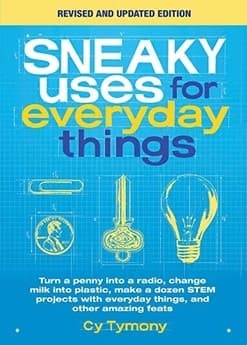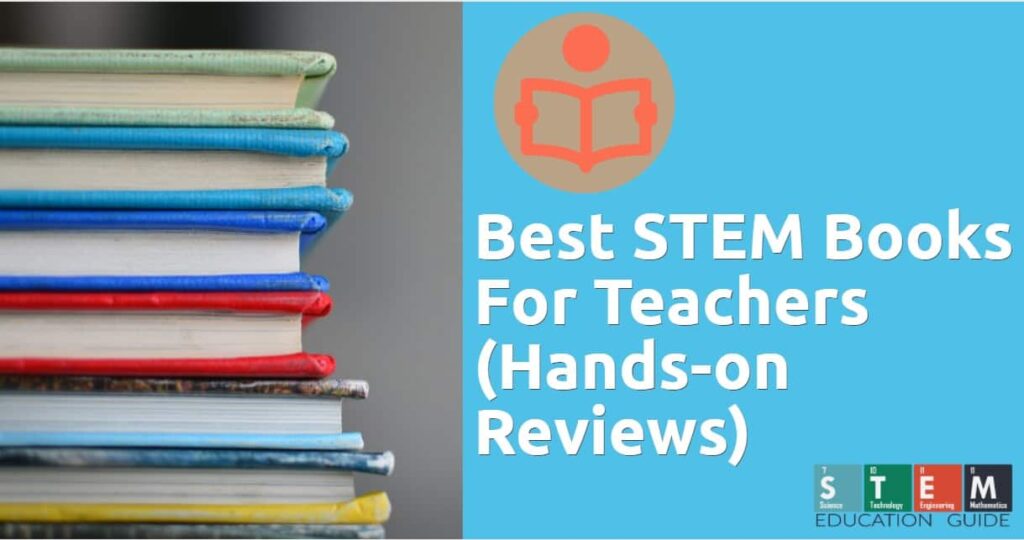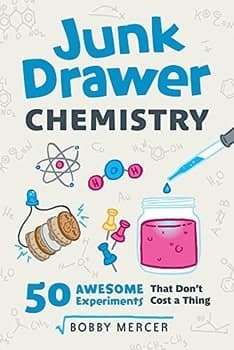These STEM books are for kids in middle school that are fascinated by all things science.
I find that many book recommendations for middle schools are non-fiction. I know that kids want to learn about factual subjects, so I searched high and low for STEM books that will delight any kid around the age of ten to fourteen.
I personally purchased each book I’m recommending for these reviews, and I give my thoughts about each of them in the overview of the book.
If you’re looking for STEM ideas to do in a classroom or at home, take a look at my FREE STEM activities eBook that I made with my kids, you can download it here:

Table of Contents
Sneaky Uses for Everyday Things
This book delivers on what it promises. It’s filled with sneaky and clever uses with stuff you’ll have laying around the house.
I like the easy-to-navigate way the book is laid out. Sections like tricks and gimmicks, survival techniques, and the most interesting one, STEM magnet and motor projects.
The book is perfect for kids that don’t have much money to spend but still want to find plenty of projects to do. In the section that uses magnets, the author finds over 25 different everyday things that have magnets to take apart. Most of this stuff would be considered junk, so no harm, no loss.
All the illustrations are hand-drawn and clear to follow.
If your kids like to tinker, take things apart, and make interesting sneaky gadgets, they will love this book!
Author: Cy Tymony. Cy has a ton of excellent books for teenagers; you can find them all here.
Why We Love It:
- Clear instructions with illustrations.
- You won’t need anything special for most of these ideals.
Check the current price of Sneaky uses for everyday things book here.
Homemade Robots: 10 Simple Bots to Build with Stuff Around the House
Homemade Robots is another book like the one above. It’s for kids that like to tinker and build things.
The book starts off with clear instructions and a list of things you’ll need to build these tiny robots. With stuff like an old CD disc (used as wheels for a robot). Tools required are probably things you have lying around.
Some of the other small things, like a little motor, are easy to find. I’ve built these robots with my son, and you can find a kit like this for a few bucks.
Something else the author goes over is how to solder, but it’s not necessary for every build. Soldering is a lifetime skill for people that like to put electronics together. So it’s not a bad idea to learn young.
Soldering kits can be picked up on the cheap as well. You can find a kit here.
What you’ll learn:
- How to build ten different simple robots.
- Learn how to solder the correct way.
- Get a firm grasp on how to make electrical circuits.
Overall, I think a middle schooler or any teenager will enjoy this book if they like electronics.
Author: Randy Sarafan. He has a few different books for teenagers you can find here.
Why We Love It:
- Perfect for teenagers that want to build their own robot at home.
- Clear pictures that explain every project.
You can find the paperback and Kindle edition here.
A Young Innovator’s Guide to STEM: 5 Steps To Problem Solving For Students, Educators, and Parents
This book is a no-nonsense guide for young innovators.
You’re not going to find any STEM projects like building robots or other activities. It’s for a middle schooler that has an idea but needs a road map on how to see the ideal all the way through.
I like that the author goes through the process of innovation. Sometimes inventions and innovations get romanticized in our society. We’ve all heard of an inventor having a dream with the solution just popping into their head.
This isn’t the case in real life, at least not for the majority of innovators. Great ideals go through a process of trial and error. The book has an entire chapter about this labeled, what is innovation?
I also like that there is a dedicated chapter on how to brainstorm to find solutions to problems. And how to figure out solutions through a process of elimination.
Author: Gitanjali Rao.
Why We Love It:
- Step-by-step guide on how to push our innovations to completion.
I made a list of the best STEM books for teachers. I reviewed each one and give a summary of my thoughts. This list is for teachers of every age.
62 Projects to Make with a Dead Computer: (And Other Discarded Electronics)
This book is dedicated to kids who like to tinker and take apart stuff, but with a twist.
It’s actually an art project book using old or discarded electronics.
That’s not what I thought the book was about when I purchased it, but I was pleasantly surprised.
It’s not all art, as the author goes into great detail about how electronics work, how to solder and fix old electronics. This is an excellent way of breathing new life into stuff that would otherwise just end up in a landfill somewhere.
Perfect for a teacher or a homeschool parent:
- All projects are clearly laid out with illustrations.
- Using stuff people are just going to through away anyway, so everything should be free or very low cost.
- Teach students how to use electronics and build something new.
This was another book I’m glad I picked up, and I plan on doing some of the projects with my kids.
Author: Randy Sarafan. He has a few different books for teenagers you can find here.
Why We Love It:
- Art projects that incorporate STEM.
- Reusing old gadgets and computers most people think are junk.
You can find the book in Kindle or paperback here.
The Way Things Work Now
When I first flipped through this book, my first thought was that it would be great sitting on a coffee table. Everything is so interesting in it!
It has all the little questions about how things work that you didn’t know you had, like how a zipper works (it’s actually quite interesting), how a bathroom scale works, or an e-reader.
This book is filled with tons of things like that. They are all bite-size and easy to read. You can flip the book open to any page and find the topic interesting.
The illustrations are fantastic, and there are a lot of them, but they make the book seem like it’s for younger children, which it’s not. It’s far too text-heavy, but I can see young kids who can read well enjoy this book.
Author: David MacAulay. David has dozens of great books for kids, you can find them all here.
Why We Love It:
- Every page and topic is fascinating!
- Perfect for keeping on your table because the topics are quick reads.
You can find The Way Things Work Now in hardcover or Kindle here.
Why STEM for girls? I cover that in our reviews of the best STEM books for girls of any age.
Artificial Intelligence: Thinking Machines and Smart Robots with Science Activities for Kids
If you have a kid in middle school interested in AI, they are in for a wild ride with this book.
It breaks down all your questions about AI into simple to understand answers. From what AI is to how we will use it in the future.
I like that the book starts with the history of AI. I never realized it goes back to the 40s when Isaac Asimov published the three laws for AI.
The book is written out so it’s easy to read and has exciting facts kids will enjoy along the way. Illustrations are a mix of actual pictures and cartoon illustrations. Nothing is offsetting, and both styles flow together.
This would be an excellent gift for a teenager interested in computers and software. We use AI every day, and that trend will continue.
Author: Angie Smibert. Angie has a ton of books about science for kids. You can find them all on her page here.
Why We Love It:
- Explains AI for kids with little to no knowledge of the subject.
- The writing style makes the chapters flow nicely, making them easy to read.
The book is available in hardcover, paperback, and Kindle here.
A Kids’ Guide to the Periodic Table: Everything You Need to Know about the Elements
This book breaks down each of the 118 elements on the periodic table. From their history to what we use them for today.
The ones I read came off as interesting, and I think a middle school that is into chemistry will find this book fun and interesting. It also goes over where elements are mined and how we use them daily.
Author: Edward P. Zovinka PhD.
Why We Love It:
- Interesting facts about each element.
- Explains how we use each element today.
Junk Drawer Chemistry: 50 Awesome Experiments That Don’t Cost a Thing
Junk Drawer Chemistry is another book perfect for classrooms or homeschool parents. It finds a way of performing chemistry experiments from everyday stuff you have lying around your house.
I like that no expensive equipment needs to be purchased. Many of the items your middle schooler will need can probably be found in the trash or stuff your school throws away every day.
The 50 experiments in the book are clever and not ones you’ve seen all the time. A few of them I’ve done with my kids to their delight.
I like that after each experiment, the author explains what is happening and why. Some books I’ve reviewed have left the reader on their own and do not explain the why.
All the pictures are taken close-up of the activities. Some of them are with the person’s hands, showing what to do. It looks like the photos were taken on a cellphone, not professionally taken.
I kind of like this, not overly polished photos. It shows a real person performing the chemistry in a real home, not a studio.
Author: Bobby Mercer. He has a lot of books like this that any middle schooler would love. You can see all of Bobby Mercer’s books here.
Why We Love It:
- Use stuff you were going to throw away to perform fun educational activities.
- Clearly states how the experiments are performed and why they went the way they did.
You can find Junk Drawer Chemistry on paperback and Kindle here.
Coding for Kids: Python: Learn to Code with 50 Awesome Games and Activities
I’ve gone through many coding books for various articles on this site. As well as courses with my nine-year-old son. I chose this book because I feel it’s perfect for a middle school-aged kid to get started with coding.
I usually recommend young kids get started with Scratch programming. Before stepping into Python or Javascript, you can think of it as a visual way of coding.
I don’t think a kid 11 to 13 years old needs to start with Scratch, as my son moved on when he was younger than that. There’s only so much a kid can do with it before getting bored.
The most important thing for a kid getting started in coding is that they have fun with it!
That’s why it will be excellent for kids to build their own games and activities with this book.
The book lays out everything you’ll need to get started. All the software is free, but your kids will need a computer with a mouse and keyboard. So if you only use an iPad or other tablet, you’ll have to pick up a cheap computer, nothing fancy.
The only knock on this book over other coding books for kids is the lack of pictures. It will hold your hand to get through the projects and how to write code, but a few more visual cues would have been nice.
Author: Adrienne Tacke.
Why We Love It:
- Easy way to get started with coding.
- Building fun projects keep kids interested.
If your kids are interested in coding, I highly recommend a coding course specifically for kids. My son uses Code Monkey and he loves it.
The book is available in spiral-bound, Kindle, and paperback here.
The Flying Machine Book: Build and Launch 35 Rockets, Gliders, Helicopters, Boomerangs, and More
This is another book from Bobby Mercer, that wrote Junk Drawer Chemistry above.
It’s the same style, with lots of pictures of someone making each flying project. I also recommend this for a classroom or a group of kids. All the material you’ll need you probably already have.
Many of these are complex that older kids will want to focus on. There are plenty of simple, quick, and easy flying machines as well.
I like that the author goes into detail about why each shape works and the physics behind it.
If your kid is an aviation geek, they will go crazy over this book.
It’s not just airplanes you’ll be making. There are plenty of helicopters, rockets, boomerangs, and other flying contraptions to put together.
Author: Bobby Mercer. He has a lot of books like this that any middle schooler would love. You can see all of Bobby Mercer books here.
Why We Love It:
- Great for a large group.
- Easy to more challenging builds.
The book is in both paperback and Kindle format, which you can find here.
Girls Think of Everything: Stories of Ingenious Inventions by Women
This book is filled with unique illustrations. They are all drawn in the same style, which is sure to grab a girl’s interest. Information about each woman is engaging and includes a few women I hadn’t heard of until reading the book.
Each chapter highlights influential women and their contributions to science.
This isn’t a DIY book like the others I’ve reviewed, but a young lady will find this inspirational.
The book is text-heavy and is targeted at girls 12 and older.
Author: Catherine Thimmesh. She has a lot of books about science and animals girls will find interesting. You can find the complete list here.
Why We Love It:
- Fantastic hand-drawn illustrations.
- Chapters are separated by women in science so that you can jump around from chapter to chapter.
You can find the book in kindle format or hardcover here.
Math Maker Lab: 27 Super Cool Projects
This book is dedicated to STEM math activities. Each math project includes instructions on creating art and craft hobby. Making an Abacus, optical illusions, and tessellation patterns are some of my favorite parts of the book.
Everything is clearly written, and photos are well taken. This math activities book is not recommended for younger children. The book is best for children 13 and older.
Even if your children are younger, they’ll still love crafting, but you will have to guide them through each step. You might still have to explain why you are doing it, even if you go step-by-step. They will enjoy the math projects.
That’s why I’m recommending it for middle school-aged kids and older.
This book can help your children see that math is fun, even if they have trouble with math classes right now in school.
Author: DK Publishing
Why We Love It:
- Clear photos and step-by-step instructions.
- Creative ideas, most of them I haven’t seen before.
Check out the current price of Math Maker Lab here.
The Vinyl Frontier: The Story of NASA’s Interstellar Mixtape
I’m including a book I read last year to round out our list. This is the story about the recoded NASA put on the Voyager probe, which is about 15,000,000,000 miles from earth right now.
The Golden Record is a 90-minute playlist of music from around the world. It also includes spoken greetings in multiple languages and more than 100 photos.
It’s a fascinating read for anyone interested in science and technology. The book has interviews with key people that made this happen and the problems they faced.
Author: Jonathan Scott
Why We Love It:
- Great story about people persevering despite constant setbacks.
- If you’re interested in space, you’ll love this too!
You can find the audiobook, paperback, and Kindle edition here.
Wrapping Up
I hope you enjoyed my list. I only included the ones I think the major of Middle schoolers would enjoy too.
Not all books made the list, but if you have a book recommendation that you think needs to be on here. Please let me know in the comments, and I will purchase it and review the book.
Please check out our list of the best STEM activities books.
























